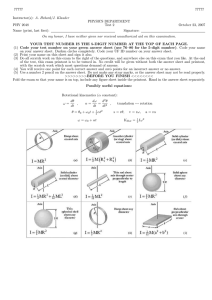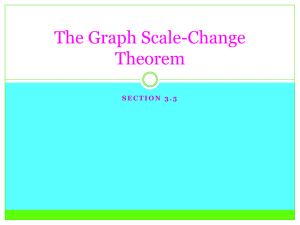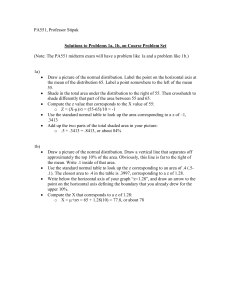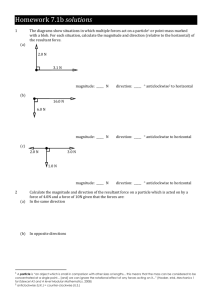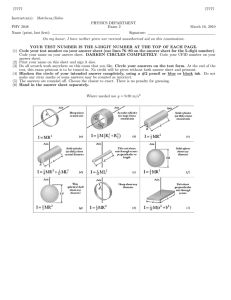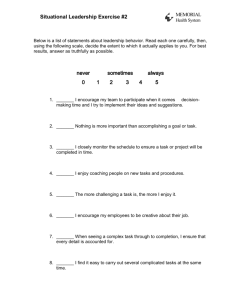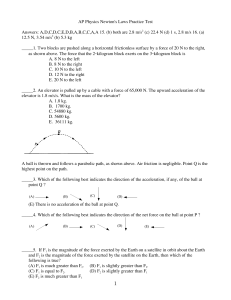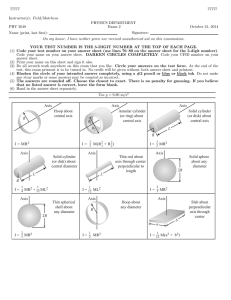77777 Matcheva/Sabin PHYSICS DEPARTMENT PHY 2048
advertisement
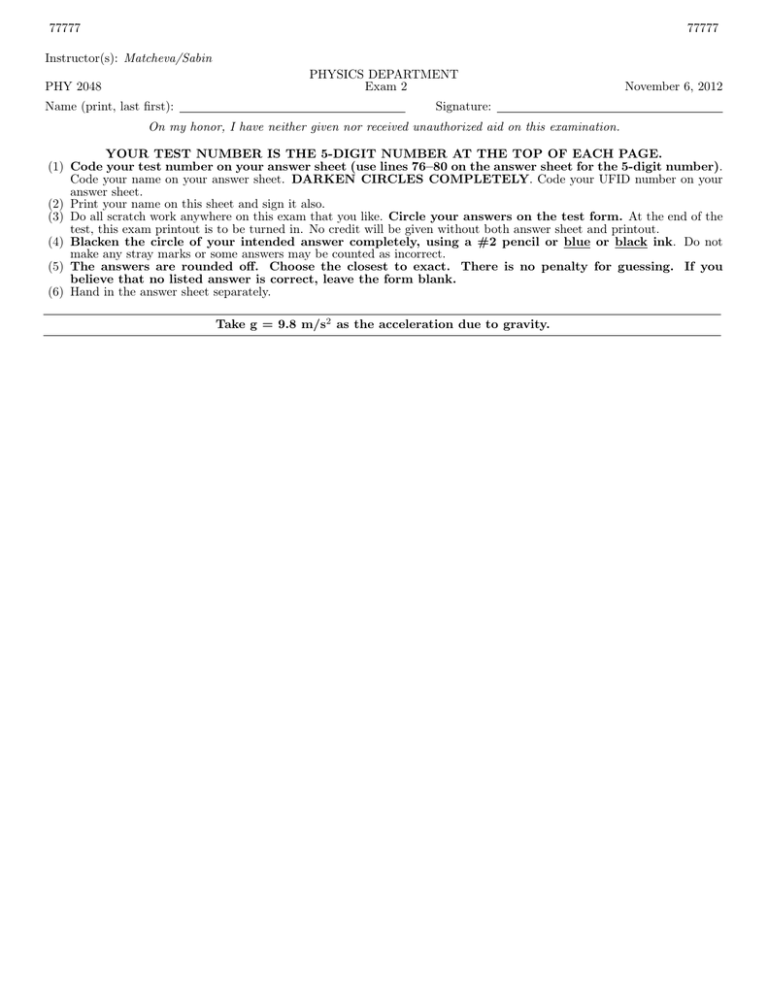
77777 77777 Instructor(s): Matcheva/Sabin PHYSICS DEPARTMENT Exam 2 PHY 2048 Name (print, last first): November 6, 2012 Signature: On my honor, I have neither given nor received unauthorized aid on this examination. YOUR TEST NUMBER IS THE 5-DIGIT NUMBER AT THE TOP OF EACH PAGE. (1) Code your test number on your answer sheet (use lines 76–80 on the answer sheet for the 5-digit number). Code your name on your answer sheet. DARKEN CIRCLES COMPLETELY. Code your UFID number on your answer sheet. (2) Print your name on this sheet and sign it also. (3) Do all scratch work anywhere on this exam that you like. Circle your answers on the test form. At the end of the test, this exam printout is to be turned in. No credit will be given without both answer sheet and printout. (4) Blacken the circle of your intended answer completely, using a #2 pencil or blue or black ink. Do not make any stray marks or some answers may be counted as incorrect. (5) The answers are rounded off. Choose the closest to exact. There is no penalty for guessing. If you believe that no listed answer is correct, leave the form blank. (6) Hand in the answer sheet separately. Take g = 9.8 m/s2 as the acceleration due to gravity. 77777 77777 Take g = 9.8 m/s2 as the acceleration due to gravity. 1. A 0.50-kg object moves in a horizontal circular track with a radius of 2.5 m. An external force of 3.0 N, always tangent to the track, causes the object to speed up as it goes around. The work done by the external force as the mass makes one revolution is: (1) 47 J (2) 24 J (3) 59 J (4) 94 J (5) 120 J 2. Two masses, m1 and m2 , have the same kinetic energy and are both moving to the right. The same constant force F~ is applied to the left to both masses. If m1 = 4m2 , the ratio of the stopping distance of m1 to that of m2 is: (1) 1:1 (2) 1:4 (3) 4:1 (4) 1:2 (5) 2:1 3. A 50-N force acts on a 2-kg crate that starts from rest. When the force has been acting for 2 s, the rate at which it is doing work is: (1) 2500 W (2) 75 W (3) 100 W (4) 1000 W (5) 5000 W y 4. A ball is held at a height H above the floor. It is then released and falls to the floor. If air resistance can be ignored, which of the five graphs below correctly gives the mechanical energy E of the Earth-ball system as a function of the altitude y of the ball? H 0 E (1) E H y (2) E H y E (3) H y E (4) H 5. The graph to the right (A) shows the potential energy U (x) for a particle moving on the x axis. Which of the following five graphs correctly gives the force F exerted on the particle? (5) y y H U parabola (A) x F F x x (1) F (2) F F x (3) x x (4) (5) 6. A 0.75-kg block slides on a rough horizontal table top. Just before it hits a horizontal ideal spring, its speed is 3.5 m/s. It compresses the spring 5.7 cm before coming to rest. If the spring constant is 1200 N/m, the internal energy of the block and the table top must have increased by: (1) 2.6 J (2) 0 (3) 1.9 J (4) 4.6 J (5) 6.5 J 7. A man, standing at rest in a room with a horizontal frictionless floor, might be able to move across the room by: (1) throwing a shoe horizontally. (2) walking. (3) rolling. (4) exhaling vertically. (5) crawling slowly. 77777 77777 8. A 1000-kg space probe is motionless in space. To start moving, its main engine is fired for 5 s during which time it ejects exhaust gases at 5000 m/s. At the end of this process, it is moving at 20 m/s. The approximate mass of the ejected gas is: (1) 4 kg (2) 0.8 kg (3) 5 kg 5000 m/s 20 m/s (4) 20 kg (5) 25 kg 9. Two boys, with masses of 40 kg and 60 kg, respectively, stand on a horizontal frictionless surface holding the ends of a light 10 m long rod. The boys pull themselves together along the rod. When they meet, the 40-kg boy will have moved what distance? (1) 6 m (2) 4 m (3) 5 m (4) 10 m (5) need to know the forces they exert 10. A 3.00-g bullet traveling horizontally at 400 m/s hits a 3.00-kg wooden block, which is initially at rest on a smooth horizontal table. The bullet buries itself in the block without passing through. The speed of the block after the collision is: (1) 40 cm/s (2) 133 cm/s (3) 1200 cm/s (4) 4000 cm/s (5) 16000 cm/s 11. Two objects, X and Y, are held at rest on a horizontal frictionless surface. A spring is compressed between X and Y. The mass of X is 2/5 times the mass of Y. When the ojbects are released, the ratio of kinetic energy of X to that of Y is: (1) 5/2 (2) 2/5 (3) 4/25 (4) 25/4 (5) 1 12. A flywheel rotating at 12 rev/s is brought to rest in 6 s. The magnitude of the average angular acceleration in rad/s2 of the wheel during this process is: (1) 4π (2) 1/π (3) 2 (4) 4 (5) 72 13. The rotational inertia of a disk about its axis is 0.70 kg·m2 . When a 2.0-kg weight is added to its rim, 0.40 m from the axis, the rotational inertia becomes: (1) 1.0 kg·m2 (2) 0.38 kg·m2 (3) 0.54 kg·m2 (4) 0.70 kg·m2 (5) 0.86 kg·m2 14. A circular disk with a rotational inertia of 5.0 kg·m2 and a radius of 0.25 m rotates on a fixed axis perpendicular to the disk and through its center. A force of 2.0 N is applied tangentially to the rim. As the disk turns through half a revolution, the work done by the force is: (1) 1.6 J (2) 2.5 J (3) 6.3 J (4) 10 J 15. Two objects are moving in the xy plane as shown. The magnitude of their total angular momentum (about the origin O) is (in kg·m2 /s): (5) 40 J y 2 m/s 1m 3 m/s 6 kg 3 kg x O 2m (1) 6 (2) zero (3) 12 (4) 30 (5) 78 16. A 2.0-kg stone is tied to a 0.50-m long string and swung around a circle at a constant angular velocity of 12 rad/s. The net torque on the stone about the center of the circle is: (1) 0 (2) 6.0 N·m (3) 12 N·m (4) 72 N·m (5) 140 N·m 77777 77777 17. A wheel mounted on a vertical shaft of negligible rotational inertia, is rotating at 500 rpm. Another identical (but not rotating) wheel is suddenly dropped onto the same shaft as shown. The resultant combination of the two wheels and shaft will rotate at: (1) 250 rpm (2) 354 rpm (3) 500 rpm (4) 707 rpm 18. A meter stick on a horizontal frictionless table top is pivoted at the 80-cm mark. A force F~1 is applied perpendicularly to the end of the stick at 0 cm, as shown. A second force, F~2 (not shown) is applied perpendicularly at the 60 cm mark. The forces are horizontal. If the stick does not move, the force exerted by the pivot on the stick must be: (1) in the same direction as F~1 and have magnitude |F~2 | − |F~1 | (2) directed opposite to F~1 and have magnitude |F~2 | + |F~1 | (3) directed opposite to F~1 and have magnitude |F~2 | − |F~1 | (4) in the same direction as F~1 and have magnitude |F~2 | + |F~1 | (5) zero (5) 1000 rpm pivot F1 0 cm 20 cm 40 cm 19. The diagram shows a stationary uniform rod of mass m and length l held against a wall by a rope and friction between the rod and the wall. To use a single equation to find the force exerted on the rod by the rope through which point should you place the rotational axis? 60 cm 80 cm 100 cm E D θ B A (1) C (2) A (3) B (4) D (5) E 20. The ball shown, of weight 150 N, is suspended on a string AB and rests against a frictionless vertical wall. The string makes an angle of 30◦ with the wall. The ball presses against the wall with a force of: (1) (2) (3) (4) (5) none of these 520 N 300 N 600 N 173 N C 30o B 150 N A

